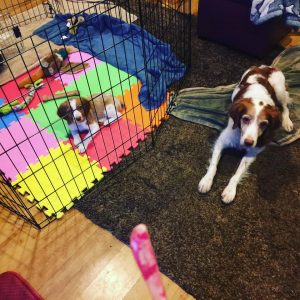1.Meet your dogs needs!
I can not say this enough. Dogs need to be understood and they have to have their needs met or you will continue to see behavior problems no matter how much training you do. Any health and medical needs should be looked at first and foremost. Did you know that my many medical issues can contribute to behavior issues? Be proactive about exams, blood work, dental health, and body work.
Dogs were designed to spend their days hunting and sleeping. The modern dog is often deprived of (appropriate) opportunities for sniffing, chewing, digging, shredding, problem solving. We can help them by ditching the food bowl. (and definitely not free feeding) Simply throwing their food in the grass in the yard is more enriching than eating out of a bowl. There are thousands of food toys and games out there. You can see some of my favorite items in the bark about it section. The book “Canine Enrichment for the Real World” by Allie Bender is a great resource for ways to provide our partners with fulfilling and stress relieving activities.
I love off leash walks for exercise where it is safe and legal check out the sniff spot app for places. A comfy harness and a long line is also great. The idea is to get off the concrete and into the woods and fields, giving them as much freedom as safe. I like to see LOTS of sniffing! Depending on your dog they may actually need to put in many more miles than you think they do.
Dogs use body language to communicate. It is pretty difficult to have a relationship with anyone without understanding what they like and dislike. So do your dog and yourself a favor and learn about reading canine body language. You need to have the ability for 2 way communication. This is difficult in our own species, let alone with another.

2. Manage your dogs environment to prevent unwanted behavior
Particularly if you have a puppy, young dog, or even an older dog that seems to be “in trouble” a lot. Crates, X-pens, baby gates, tethers and leashes are your friends because the more your dog is able to practice *insert naughty behavior here* the more difficult it will be to change. Jumping on visitors? Before guests arrive, put the dog in another room, in a crate, backyard or on a tether away from the door. ( you will need to practice some tethering skills before trying it with distractions)
Stealing food off counters? Use xpens or gates to keep your dog out of the kitchen and crate them during meal times.

3. Give your dog things that they like, for doing things that you like.
Behaviors that are reinforced will increase in frequency. If you want less jumping/barking/shenanigans. You can give your dog a bone/Kong/treat when they are laying around, or take them for a walk. It is very easy to ignore a dog when they are being “good” and hard to ignore when they are being “naughty”. This often means the humans in equation end up reinforcing the very behaviors they don’t want. The dog on the tether while guests come in? Toss some food to a quiet dog with four feet on the floor.
